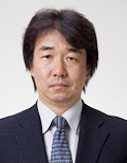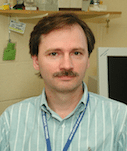The JAXA Institute of Space and Astronautical Science gave the Third ISAS Award to the following three people in January and February of 2017. We gratefully appreciate the cooperation and support we have received from external organizations, and we will continue to place greater emphasis on such cooperation.
Yuki Kimura
Associate Professor
Hokkaido University Institute of Low Temperature Science

Awarded for
Study on nucleation of cosmic dust in a microgravity environment using S-520 observation rockets
Mr. Kimura self-developed equipment with high originality for the purpose of determining the initial state of materials in solar system celestial bodies, including the earth, through microgravity experiments using S-520 observation rockets Nos. 28 and 30. As a result of these successful launches, he clarified part of the process of dust nucleation generated by late-type giant stars.
Iron is abundant in the universe, but the state in which it exists remains unknown.
Mr. Kimura successfully used an independently developed and mounted dual-wavelength interferometer to measure nucleation environments to simulate the process of dust formation from iron vapor and directly perform homogeneous nucleation experiments compatible with nucleation theory. This revealed that very high supersaturation (supercooling of around 1200 K) is necessary for homogeneous nucleation.
In addition, by establishing a group with experts on dust formation and nucleation simulation and working on analysis of experimental data, the adhesion probability at nucleation of iron atoms was found to be highly unlikely (as low as 0.001–0.01%). They showed that most of the rest is incorporated as dust impurities or condensed as dust compounds in interstellar space.
In addition, by developing a proprietary, compact “floating dust infrared spectrum in-situ measuring device,” Mr. Kimura established a method for experimentally comparing the infrared spectra of dust near celestial bodies. Using this device, we expect to determine in detail various physical and chemical parameters, such as the chemical composition, density, and temperature environment of stellar wind.
The S-520 rockets Nos. 28 and 30 made possible the significant contributions of Mr. Kimura’s experimental results.
Yuki Kimura
After working as an overseas special researcher (at NASA Goddard Space Flight Center) under the Japan Society for the Promotion of Science, and as Assistant Professor of Geology at Tohoku University, Mr. Yuki joined us in April 2014. By utilizing “in situ” observation methods using a transmission electron microscope based on materials science studies of physical properties and phenomena peculiar to nano-domains, he has been developing interdisciplinary experimental research into planetary science, astronomy, and crystal growth. In particular, he believes that the key to elucidating the cause of dust-like nanoparticles existing in the universe lies in nano-domains. He is developing the field of astro/nano-mineralogy by incorporating the unique growth modes and physical properties that characteristically appear in the nano-region into research on planetary science and astronomy.
Yoshiya Kasahara
Professor
Kanazawa University Integrated Media Platform Center (Radio Science)

Awarded for
Data Analysis of Magnetospheric Plasma Wave Phenomena by Very Low-Frequency Plasma Wave Observation Apparatus Onboard Magnetospheric Observation Satellite Akebono
Mr. Kasahara made great contributions to the operation, data analysis, database construction, and scientific results production of the very low-frequency (VLF) plasma wave measurement device mounted on the satellite “Akebono,” which completed 26 years of operation in 2015.
The VLF device performs electromagnetic field wave observations at 20 KHz or less, and was installed for the purpose of studying plasma waves associated with accelerated auroral luminescent particles and the interaction between plasma particles and waves occurring in the earth’s magnetosphere.
Mr. Kasahara was involved in the long-term operation of the VLF device, and he developed and led the VLF device database for 26 years.
Many studies have used the VLF device data, including ionic composition studies of the inner magnetosphere by ion cyclotron wave observation, the study of Whistler waves, broad electron density distributions in the plasma zone, and the cause of extremely low frequency (ELF) waves observed in the equatorial region. These studies have produced important discoveries related to the earth’s magnetosphere.
From his experience with plasma wave observations using the Akebono satellite, Mr. Kasahara contributed as a primary member to the development of a lunar radar sounder mounted on the satellite “Kaguya,” and to a plasma wave and electric field observation device onboard the Mercury Magnetospheric Orbiter (MMO). He also leads the plasma wave and electric field observation device team for the satellite “Arase,” and expects to further develop research related to wave propagation promoted by VLF waves and plasma–particle interactions.
He has greatly contributed to the creation of many of the scientific achievements of the Akebono project and related fields.
Yoshiya Kasahara
Mr. Kasahara joined us in 2008, after serving as Associate Professor of Engineering at Kyoto University, as Assistant Professor at the Graduate School of Informatics and Associate Professor in the Engineering Department of Kanazawa University, and as Associate Professor of the Center for Integrated Media Platforms. Since immediately following the Akebono launch, he has been involved in research on ELF/VLF-band plasma waves using VLF observation instruments and the operation of and databases for such observation instruments. He led the design and development of onboard processing software for the Kaguya lunar radar sounder and waveform capture (LRS/WFC) devices, the plasma wave investigation (PWI) onboard the MMO, and the plasma wave and electromagnetic observer (PWE) onboard Arase. He has been the primary investigator for the Arase PWE since 2015.
Richard L Kelley
Astrophysicist
NASA Goddard Space Flight Center

Reason for Award
The history of X-ray microcalorimeters began in 1984 with the publication by Moseley, Mather, and McCammon (MMM paper, J. Appl. Phys., 56, 1257). Immediately afterwards, Dr. Kelley started research and development of X-ray microcalorimeters at NASA Goddard Space Flight Center. Since then, he has led a large team that has pioneered both the basic physics of these devices as well as applications, including the semiconductor X-ray microcalorimeter aboard ASTRO-H SXS.
Around 1988, Dr. Kelley developed a bilinear microcalorimeter array that was used on the XQC (X-ray Quantum Calorimeter) rocket experiment. He also developed a signal processing algorithm for optimal energy resolution that has been used extensively in this field. These detector elements and the signal processing system became the prototype of ASTRO-E XRS. He has not only conducted research but has also led projects on ASTRO-E2 XRS and ASTRO-H SXS as an American PI, in close collaboration with many scientists in Japan.
Without the accumulation of his numerous research and development efforts on the X-ray microcalorimeter, namely his lifetime’s work starting in 1984, the SXS’s outstanding performance and its scientific achievement would not have been possible. Along with his great achievements, he made major contributions to the success of the SXS since the MMM publication in 1984. He also deserves praise as a representative of many American researchers.
The SXS successfully delivered superb X-ray spectra of astronomical objects with unprecedented energy resolution. This extraordinary achievement has opened a door to a new world to explore in X-ray astronomy and is paving the way for next generation space instrumentation.
Comments are closed.